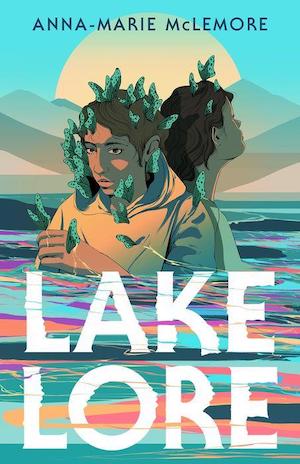The first time Bastián meets Lore, they’re children. Lore escapes their bullies and collides with Bastián at the shores of a local lake. Bastián takes Lore to a hidden world under the surface, one that no one has seen in years. The land under the lake has shifted from reality to legend to lore as far as the rest of the town is concerned. Years later, the two meet again when Lore’s family abruptly relocates to the lakeside town to escape the consequences of something terrible Lore did. Like Bastián, Lore can still see the world under the lake, but now the lake is no longer confined to its banks. All over town, but especially in their new home, the lake washes over them. Carried by its seiches are alebrijes, little papier-mâché creatures created by Bastián and imbued with their regrets and anxieties.
As much as Lore wants to keep the truth about what happened back home hidden, Bastián wants to hide what they see as their faults and failures. But the more secrets they keep, the more the lake and the alebrijes demand acknowledgement. The teens may show their friends and families a calm surface, but underneath deep waters are churning into whirlpools of emotions.
Lakelore lives in intersectionality. It’s not about just being Latinx or just being neurodivergent or just being trans/nonbinary. It’s about being all at once; it’s about the way those identities overlap, blend together, and alter each other. Lore’s dyslexia overlaps with their nonbinary-ness which overlaps with their brownness in ways they’re keenly aware of: “I’m already a brown nonbinary kid who just moved to a mostly white town. If the learning specialist gives me anything less than a sparkling review, the teachers will be even more on alert than they already are…and they’ll decide I’m a lost cause.” Likewise, Bastián is managing (and I use that word very loosely) their ADHD by saying they understand something when they don’t; they’re too ashamed to ask for help, partly because of internalized machismo, even when it means they don’t know how to give themselves their T shots.
Buy the Book


Lakelore
Lore and Bastián move through the world as nonbinary Latinx ND teens. The world is not built for any of those identities, and the consequences for deviating from the “norm” is greater because of their intersectional marginalizations. When someone doesn’t recognize or acknowledge one or more of those identities, that, too, impacts them. Whether the rest of the world sees their truth or not, whether they know how to manage, survive, and thrive in their identities, they are who they are. They can never be anything but themselves.
Even during their greatest moments of struggle and difficulty, Lore and Bastián don’t want to be anyone else. They desperately want to be seen, by their family, by their friends, by each other, by themselves. They want to be accepted fully for who they are, but that requires trust, not just in others but in themselves as well. To be vulnerable in front of the people we care about can be terrifying, especially if rejection is a possibility. I don’t think either of their families would ever shame them, but when you’re so mired in your own self-created shame spiral, it can be hard to see the love coming from everyone else.
There are no young adult authors quite like Anna-Marie McLemore. They have a way of digging into queer identities at a level no one else has really matched. We’re only just starting to see a wave of OwnVoices representation of gender identities outside the binary in young adult fiction, and more than a few of the best examples are coming from their brain. Using their own identities as Latine, trans/nonbinary, bigender, and neurodivergent as a jumping off point, they craft unique, magical realism-esque stories that revel in the complexities and contradictions of identity.
Like Anna-Marie McLemore’s other books, Lakelore is an emotional rollercoaster of a young adult fantasy novel. It’s a moving exploration of intersectionality, connection, and communication. This is a story about knowing yourself, sharing yourself with those who deserve you, and learning to trust that others will see all of you.
Author’s note: I know Anna-Marie McLemore personally and professionally. Nevertheless, I felt confident in my ability to look at this book with a critic’s and librarian’s eye, just as I’ve done with their previous works.
Lakelore is published by Feiwel & Friends.
Read an excerpt here.
Alex Brown is an Ignyte award-winning critic who writes about speculative fiction, librarianship, and Black history. Find them on twitter (@QueenOfRats), instagram (@bookjockeyalex), and their blog (bookjockeyalex.com).










